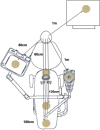Aerosols generated by high-speed handpiece and ultrasonic unit during endodontic coronal access alluding to the COVID-19 pandemic
- PMID: 35314742
- PMCID: PMC8935614
- DOI: 10.1038/s41598-022-08739-3
Aerosols generated by high-speed handpiece and ultrasonic unit during endodontic coronal access alluding to the COVID-19 pandemic
Abstract
To investigate the dispersion and contamination of aerosols generated during coronal access performed by high-speed handpiece and ultrasonic device. To measure the aerosol dispersion, a red dye or an Enterococcus faecalis culture broth inside the bottle of the water system of the dental and ultrasonic unit were used. Bovine extracted teeth were allocated in six groups according to the coronal access: G1: diamond bur in high-speed handpiece (HS) with aspiration (A); G2: ultrasonic (US) inserts with aspiration; G3: combined coronal access with HS and US with aspiration; and G4, G5, and G6 were performed without aspiration (WA). The distance reached by the aerosol with the dye was measured in centimeters, and for environment contamination, agar-plates were arranged at standardized distances for counting colony-forming units (CFU/mL). The ANOVA followed by the Tukey tests were applied (α = 0.05). The coronal access with HS generated higher aerosol dispersion and contamination, even with simultaneous A (P < 0.05), while US generated less aerosol even WA (P < 0.05). The aspiration did not reduce the aerosol statistically. HS is a great source of aerosols in dental clinic during the coronal access and the use of US device should be encouraged.
© 2022. The Author(s).
Conflict of interest statement
The authors declare no competing interests.
Figures



Similar articles
-
Mitigating saliva aerosol contamination in a dental school clinic.BMC Oral Health. 2021 Feb 5;21(1):52. doi: 10.1186/s12903-021-01417-2. BMC Oral Health. 2021. PMID: 33546674 Free PMC article.
-
Reduction of aerosol dissemination in a dental area generated by high-speed and scaler ultrasonic devices employing the "Prime Protector".PLoS One. 2023 Aug 3;18(8):e0278791. doi: 10.1371/journal.pone.0278791. eCollection 2023. PLoS One. 2023. PMID: 37535637 Free PMC article.
-
Comparative evaluation of calcium hypochlorite and sodium hypochlorite associated with passive ultrasonic irrigation on antimicrobial activity of a root canal system infected with Enterococcus faecalis: an in vitro study.J Endod. 2014 Dec;40(12):1953-7. doi: 10.1016/j.joen.2014.08.025. Epub 2014 Oct 1. J Endod. 2014. PMID: 25282371
-
Dispersion of Aerosols Generated during Dental Therapy.Int J Environ Res Public Health. 2021 Oct 27;18(21):11279. doi: 10.3390/ijerph182111279. Int J Environ Res Public Health. 2021. PMID: 34769795 Free PMC article. Review.
-
Dental bioaerosol as an occupational hazard in a dentist's workplace.Ann Agric Environ Med. 2007;14(2):203-7. Ann Agric Environ Med. 2007. PMID: 18247451 Review.
Cited by
-
Aerosol-generating procedures and associated control/mitigation measures: Position paper from the Canadian Dental Hygienists Association and the American Dental Hygienists' Association.Can J Dent Hyg. 2024 Feb 1;58(1):48-63. eCollection 2024 Feb. Can J Dent Hyg. 2024. PMID: 38505316 Free PMC article. Review.
-
Factors Related to the Intention to Use Dental Care by Industrial Workers Due to COVID-19: Application of Anderson Model and Planned Behavior Theory.Int J Environ Res Public Health. 2022 Oct 8;19(19):12883. doi: 10.3390/ijerph191912883. Int J Environ Res Public Health. 2022. PMID: 36232183 Free PMC article.
-
Bioaerosols and Airborne Transmission in the Dental Clinic.Int Dent J. 2024 Nov;74 Suppl 2(Suppl 2):S418-S428. doi: 10.1016/j.identj.2024.09.026. Int Dent J. 2024. PMID: 39515929 Free PMC article. Review.
-
Bioaerosol distribution characteristics and potential SARS-CoV-2 infection risk in a multi-compartment dental clinic.Build Environ. 2022 Nov;225:109624. doi: 10.1016/j.buildenv.2022.109624. Epub 2022 Sep 22. Build Environ. 2022. PMID: 36164582 Free PMC article.
-
The Efficacy of an Extraoral Suction Apparatus on Reduction of Splatter Contamination during Impacted Lower Third Molar Surgical Procedure: An Observational Study.Contemp Clin Dent. 2024 Apr-Jun;15(2):113-117. doi: 10.4103/ccd.ccd_305_23. Epub 2024 Jul 10. Contemp Clin Dent. 2024. PMID: 39206243 Free PMC article.
References
Publication types
MeSH terms
Substances
LinkOut - more resources
Full Text Sources
Medical
Research Materials
Miscellaneous

